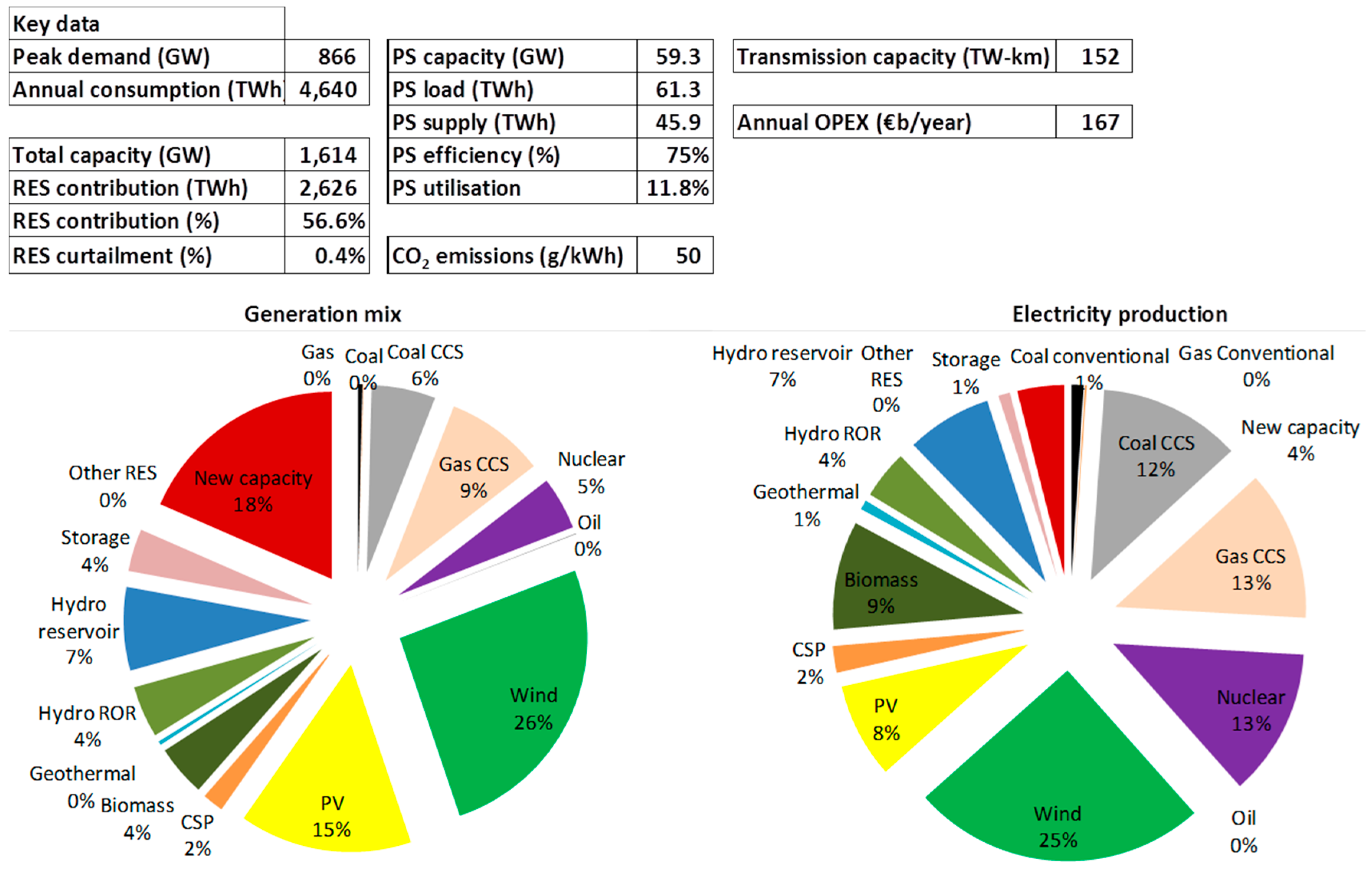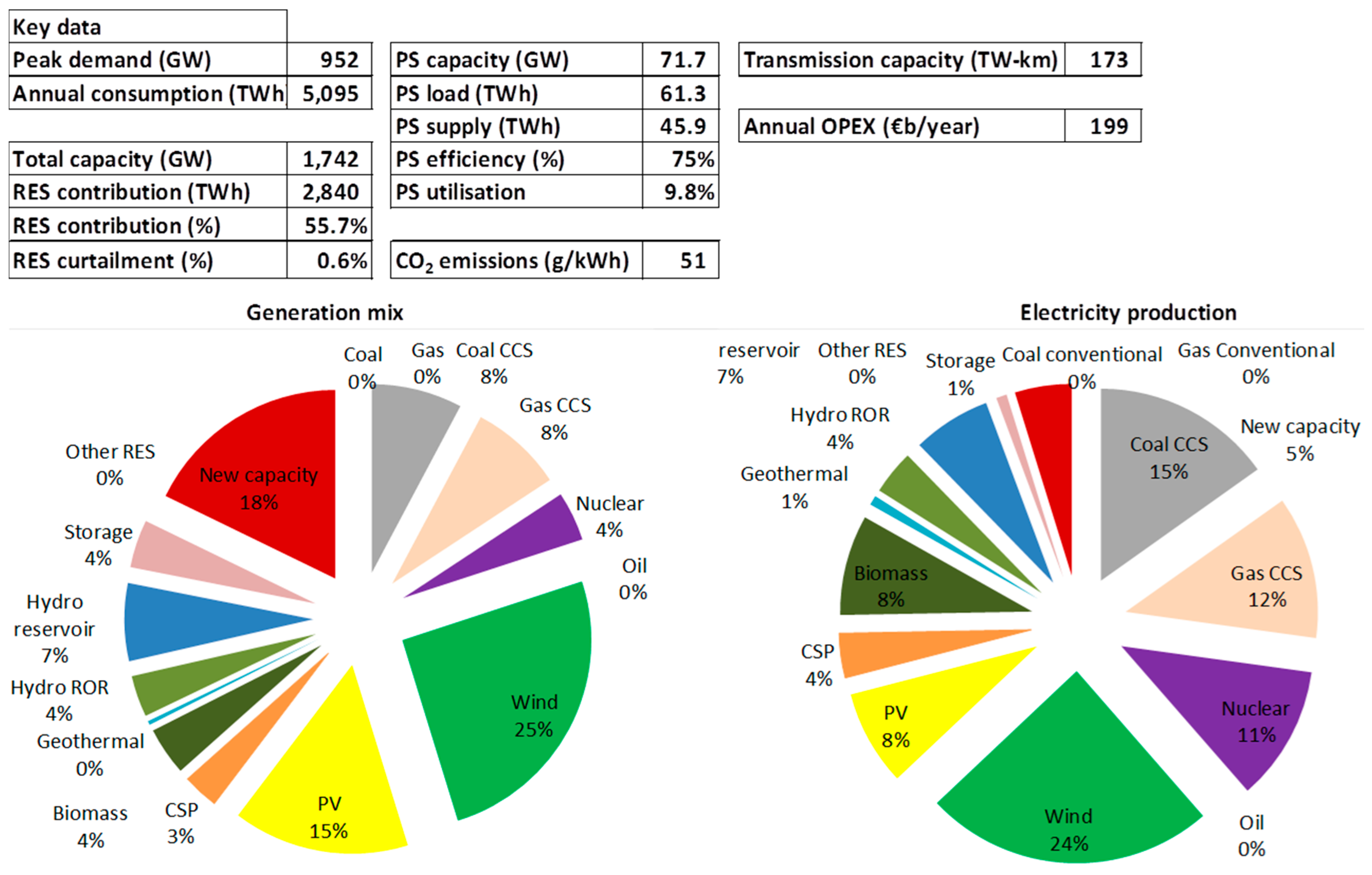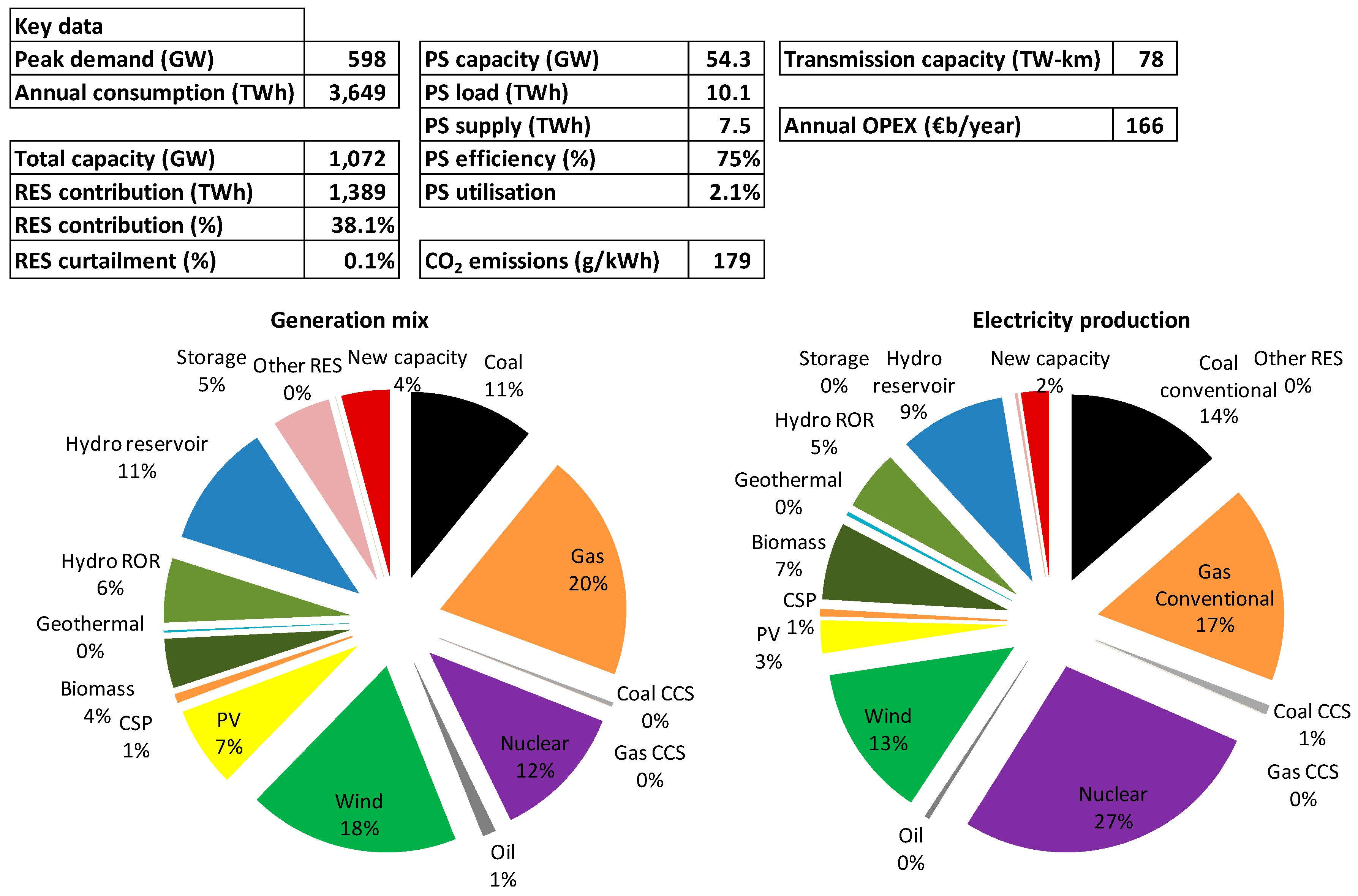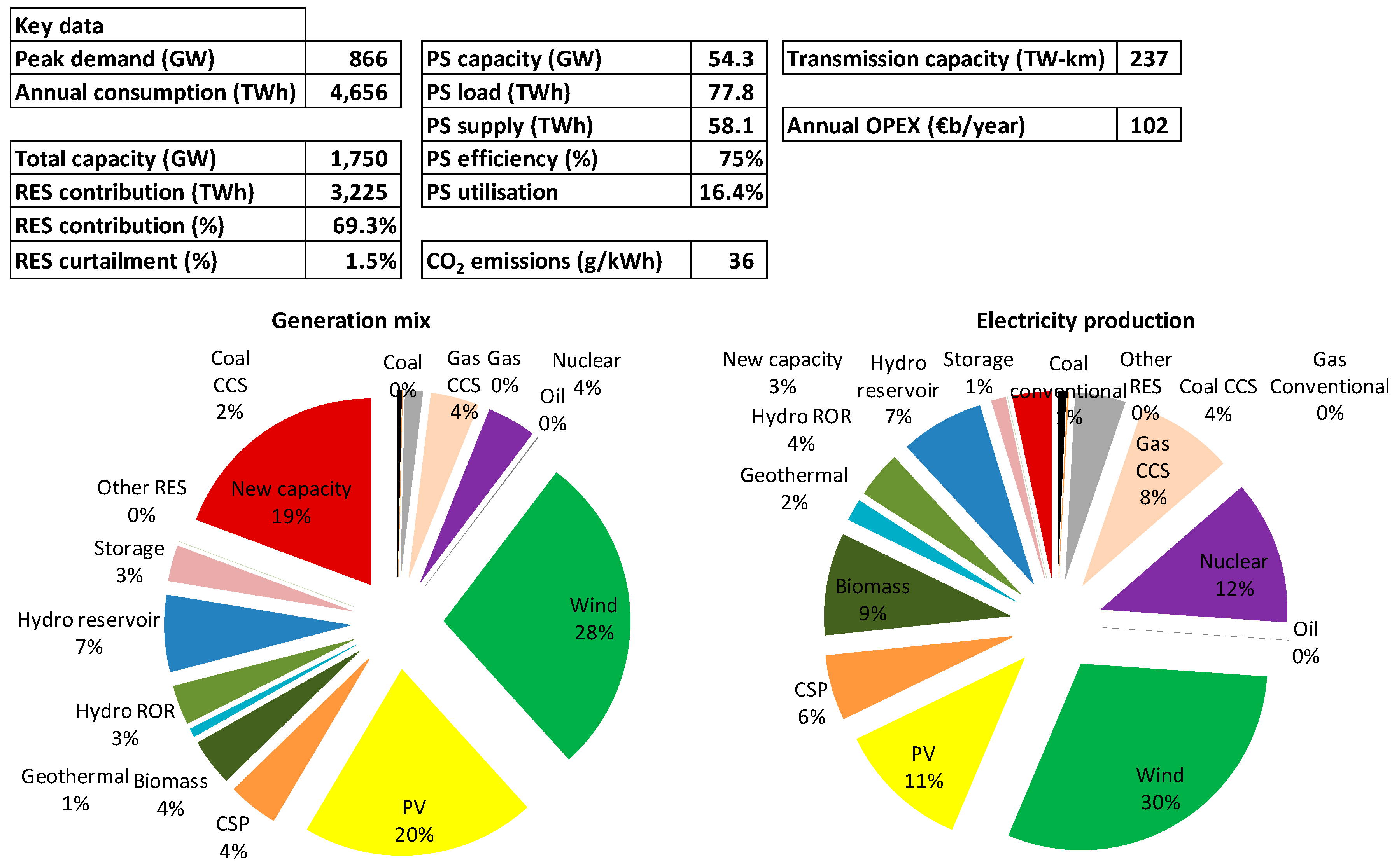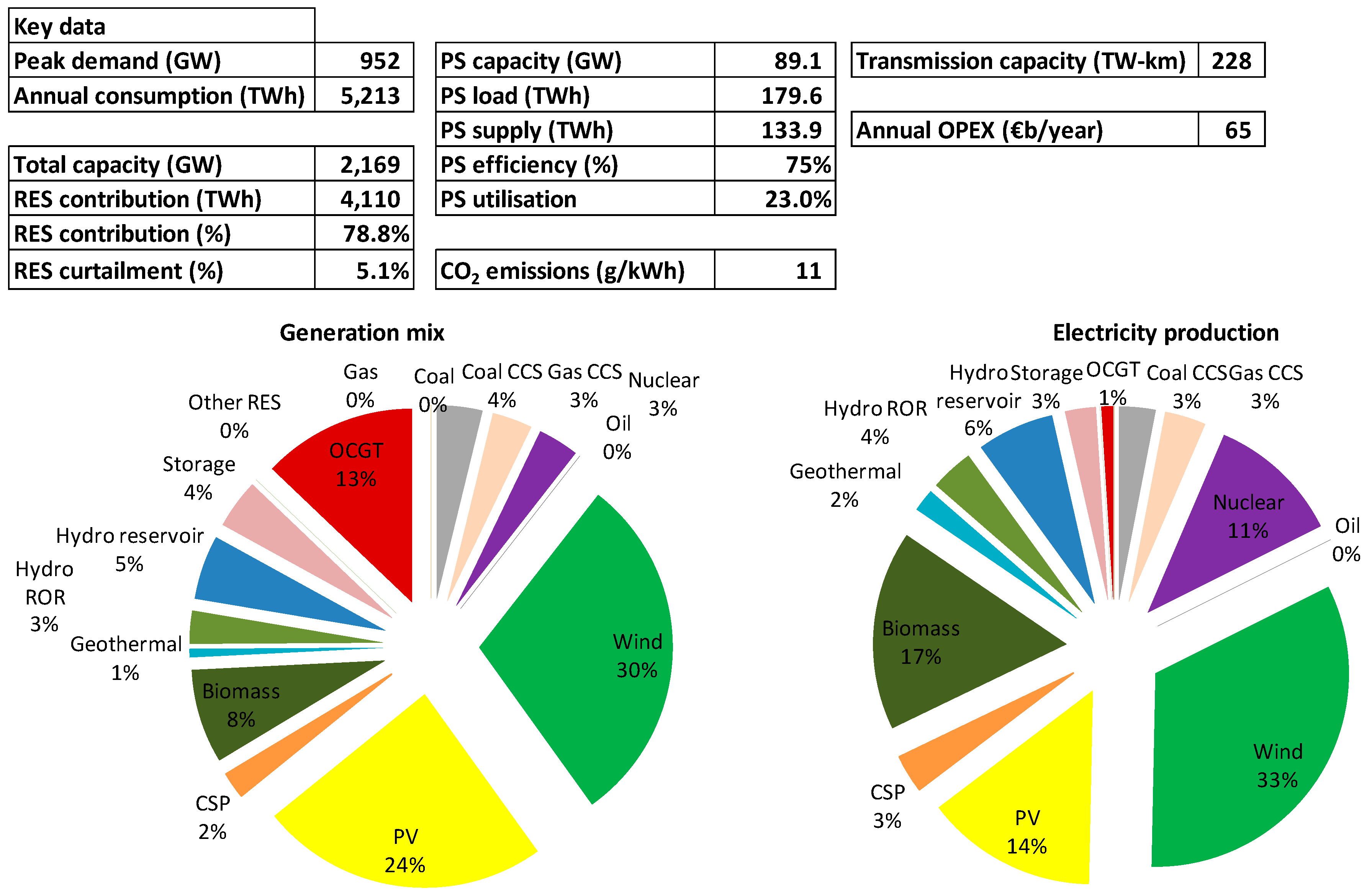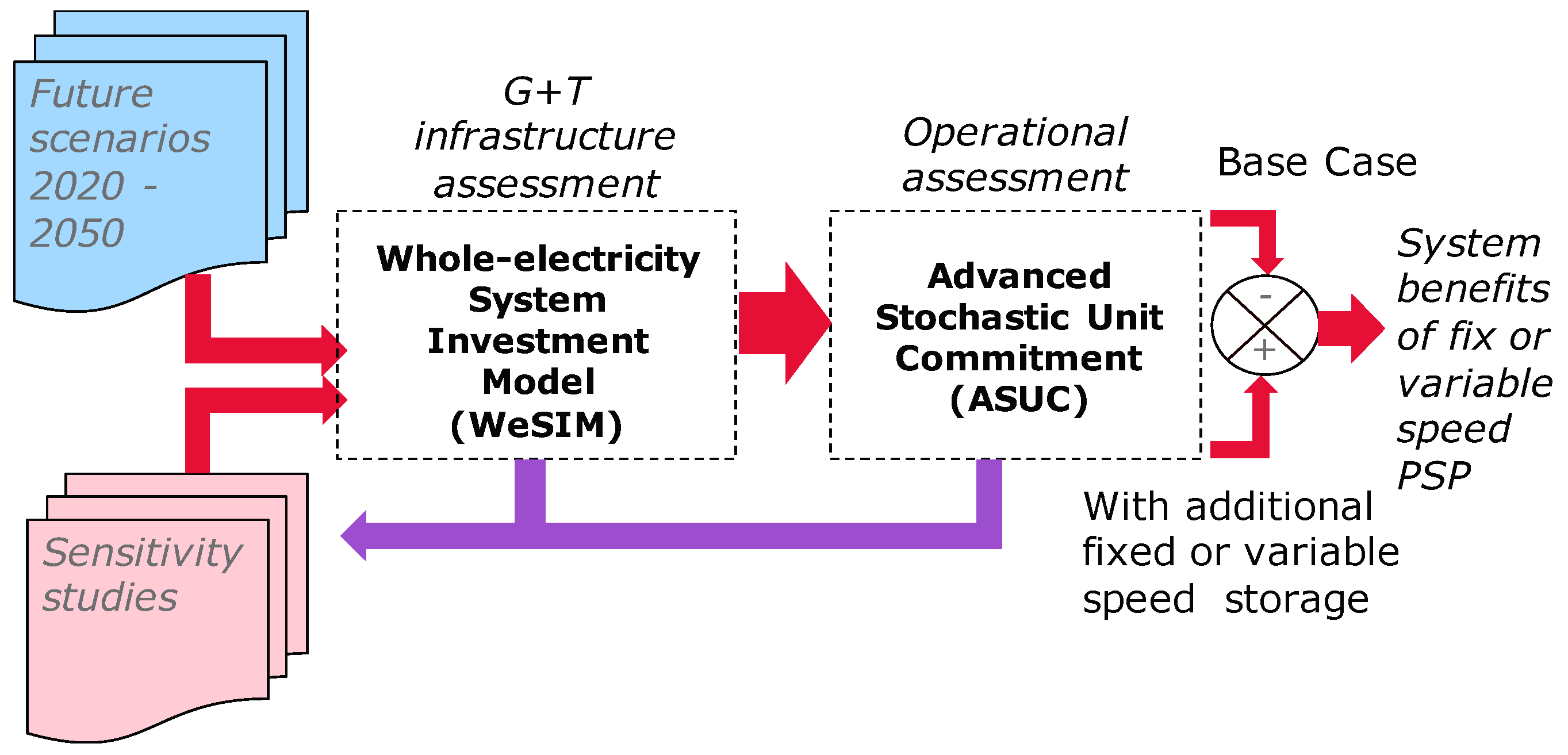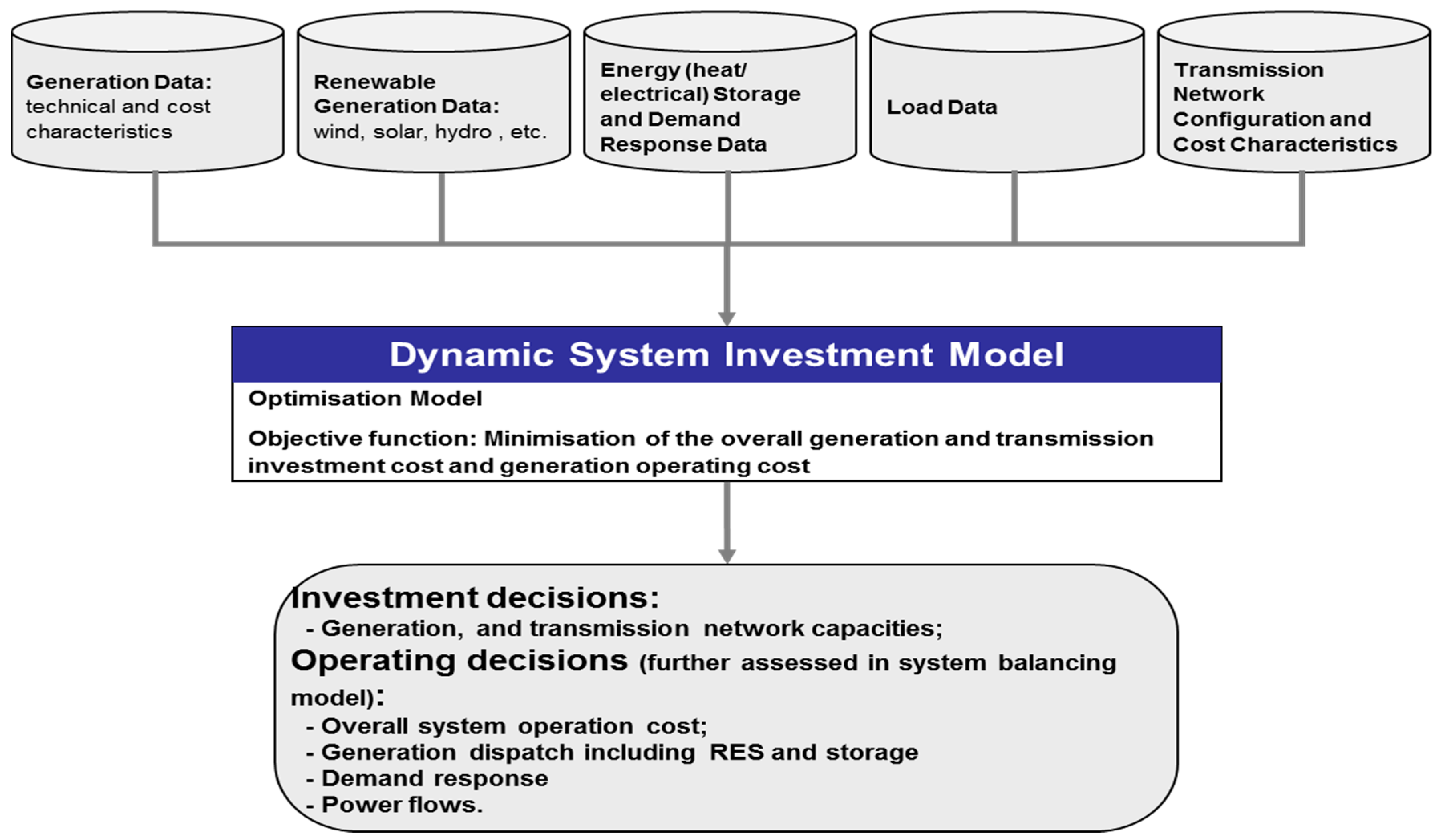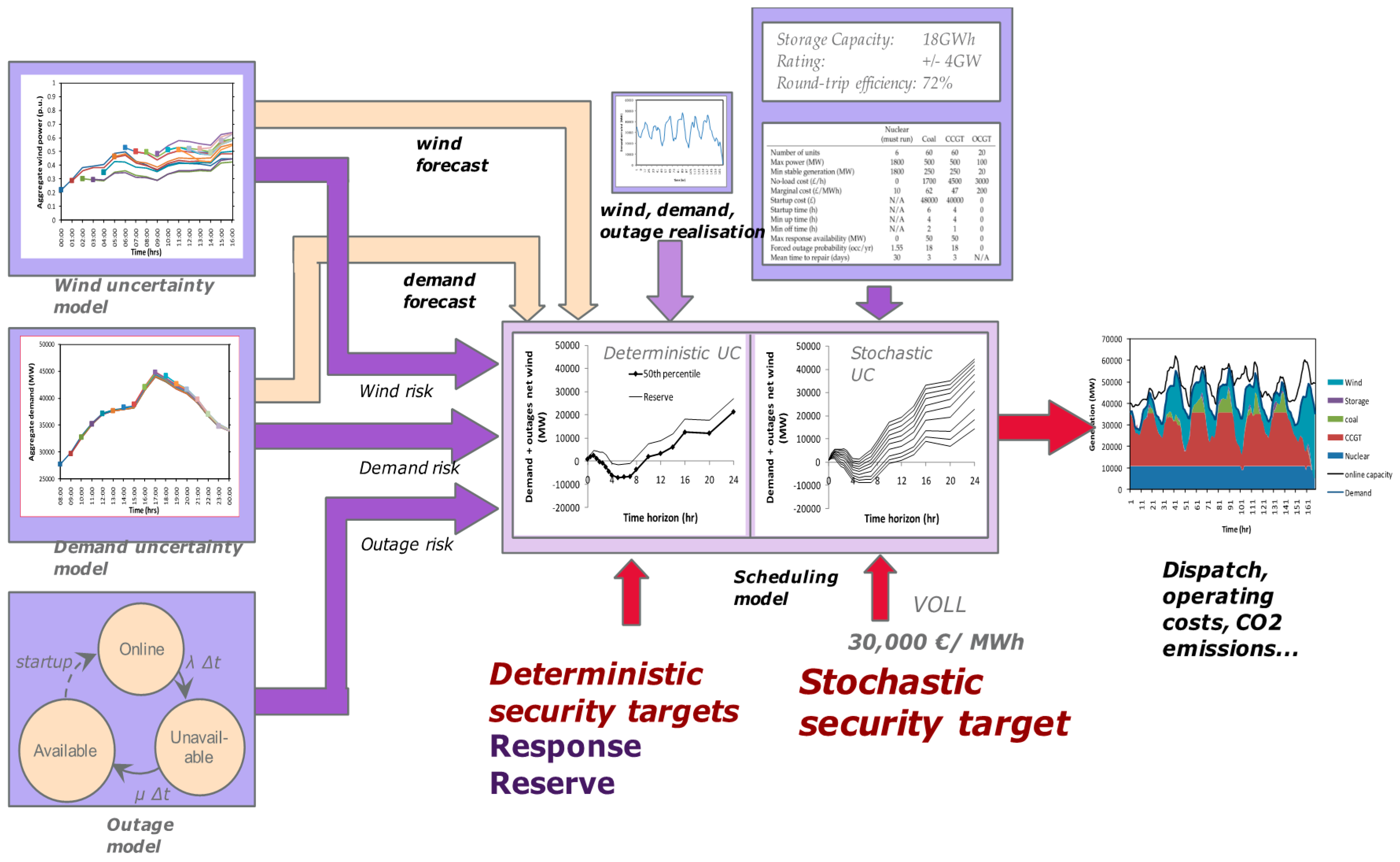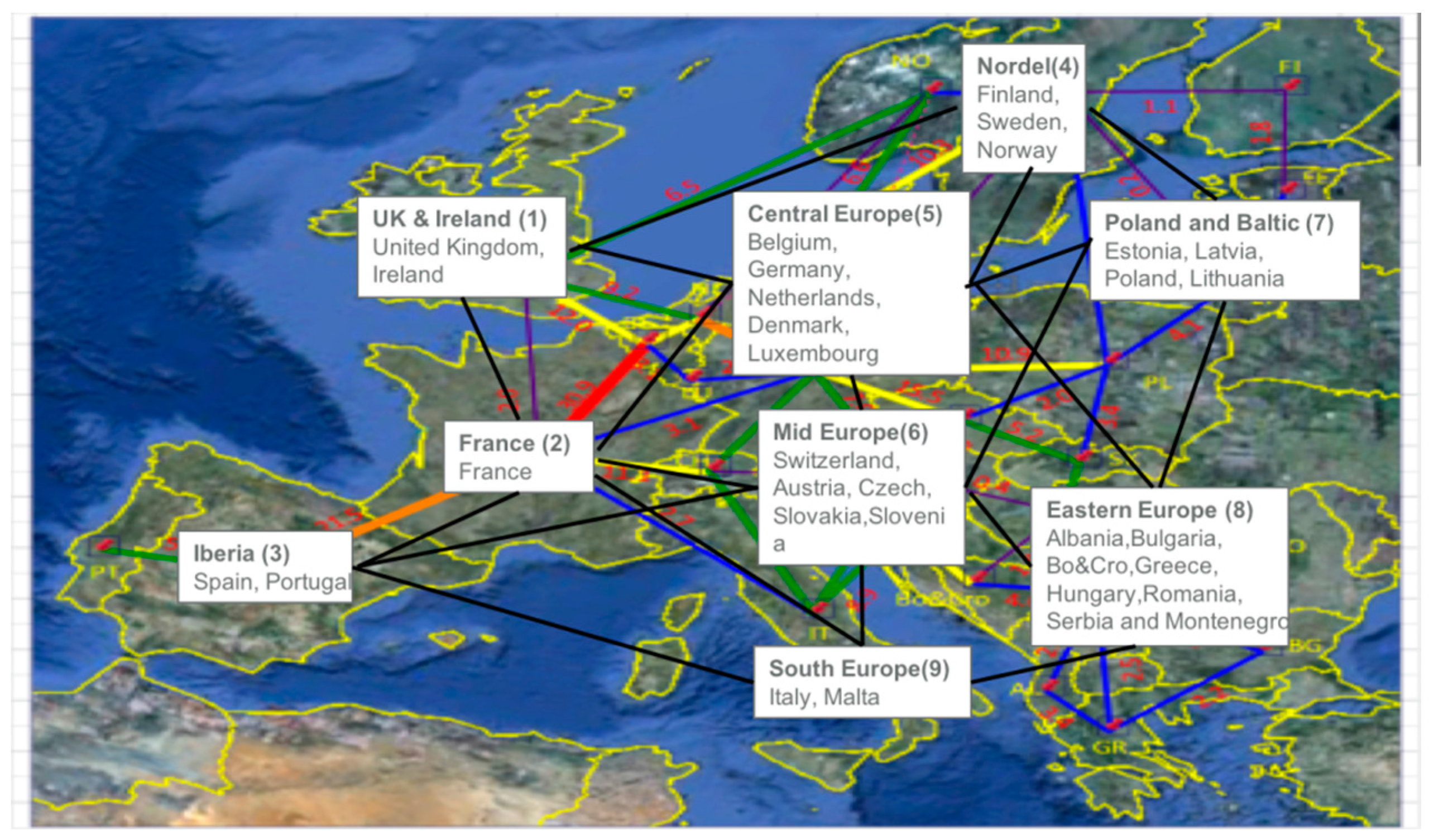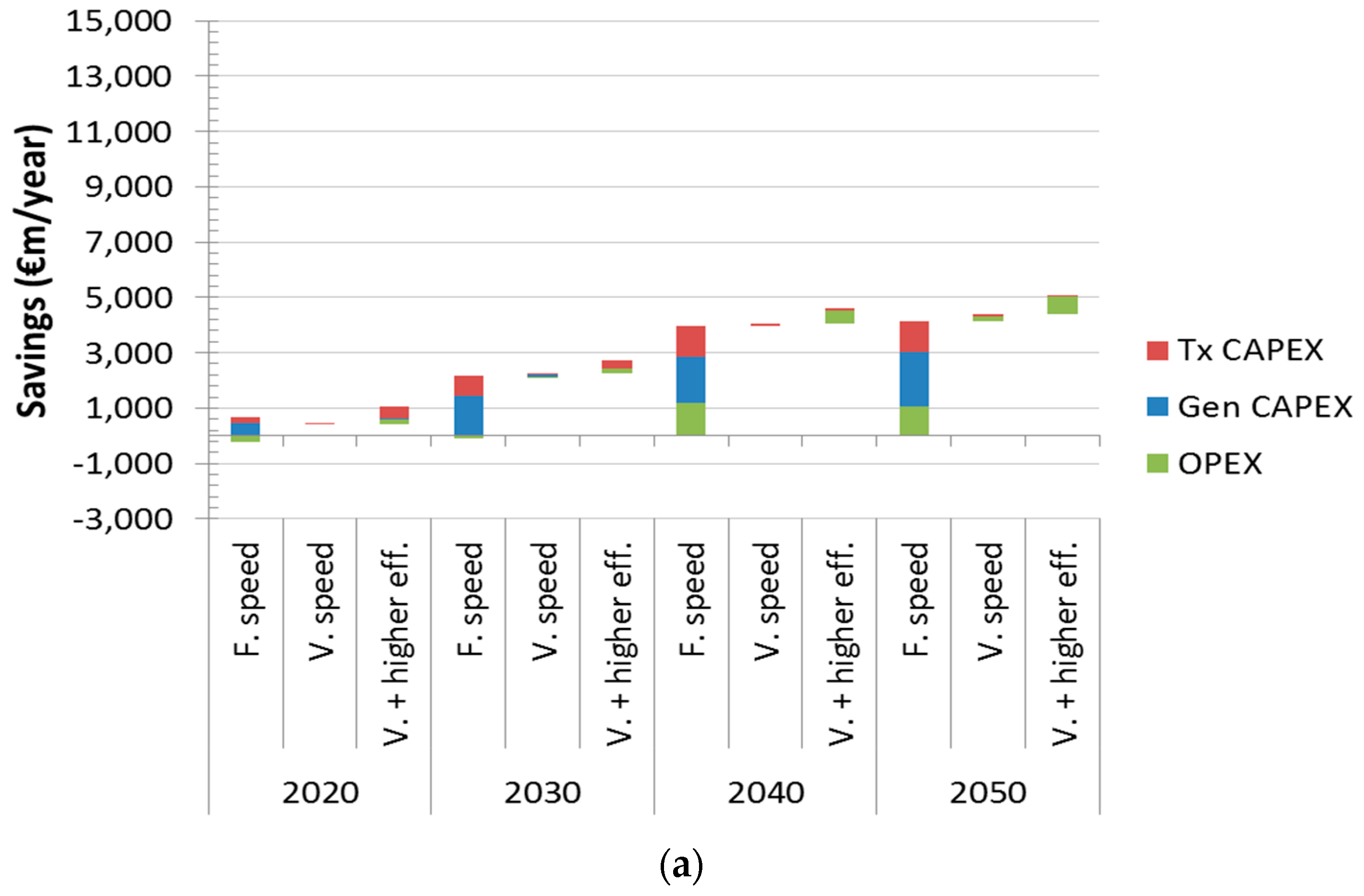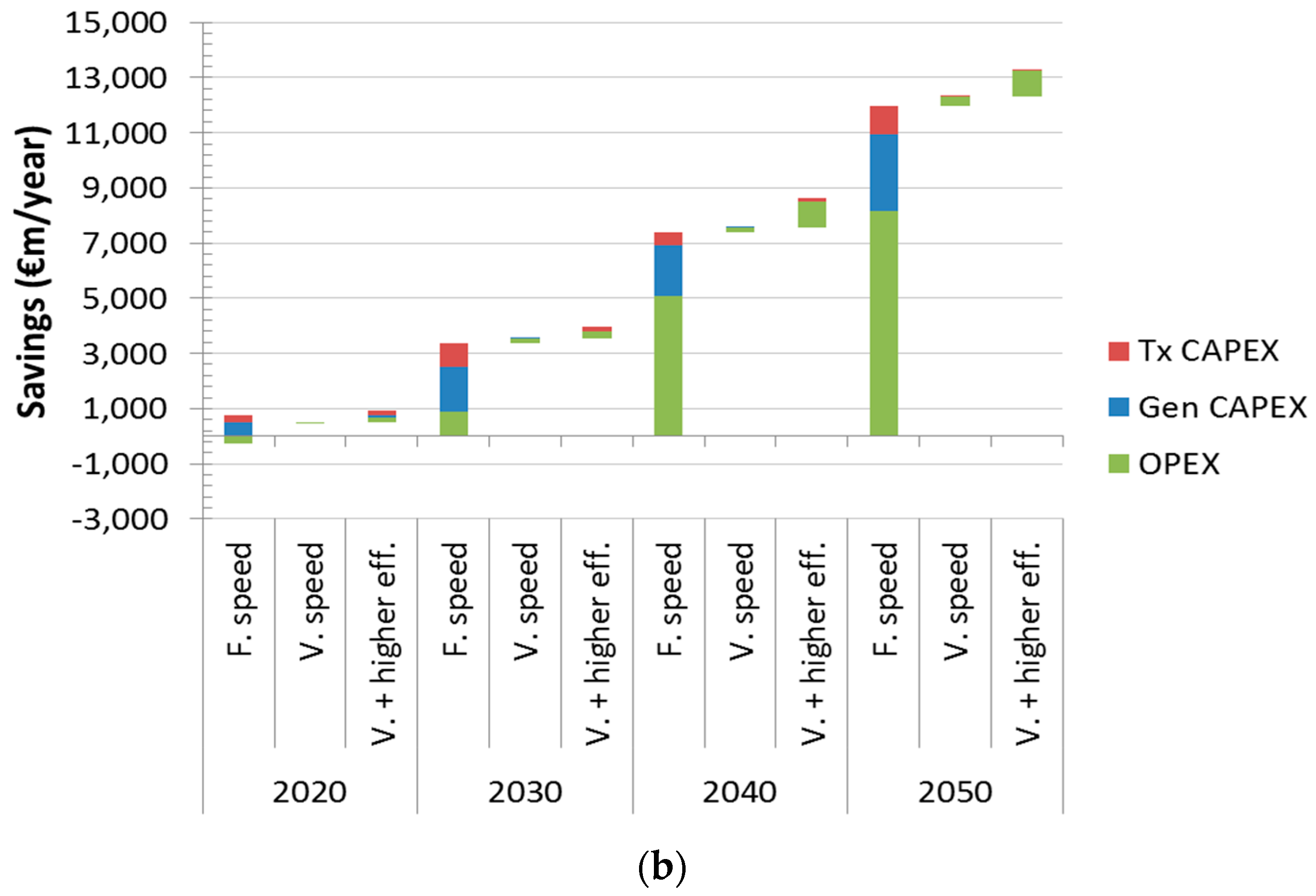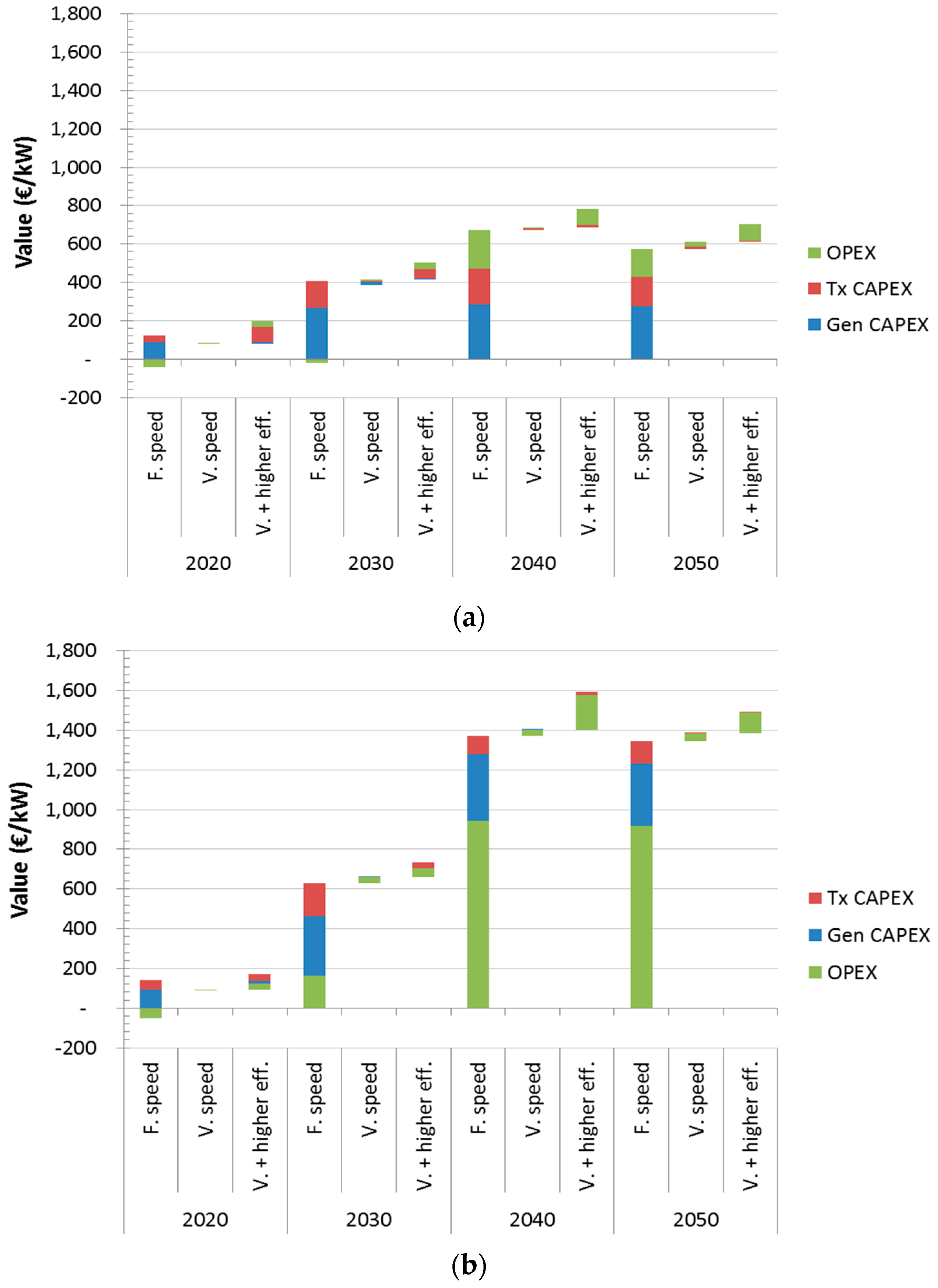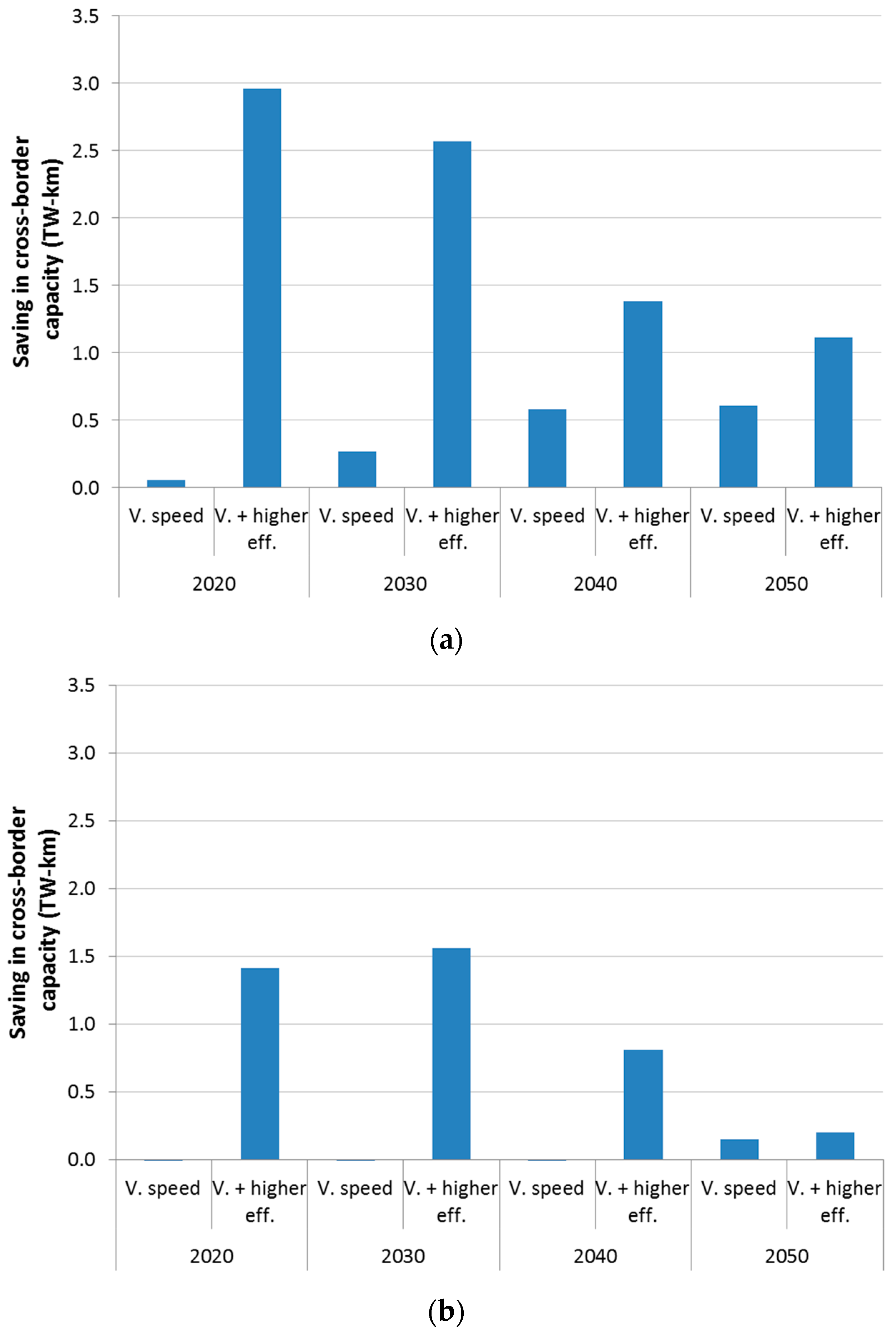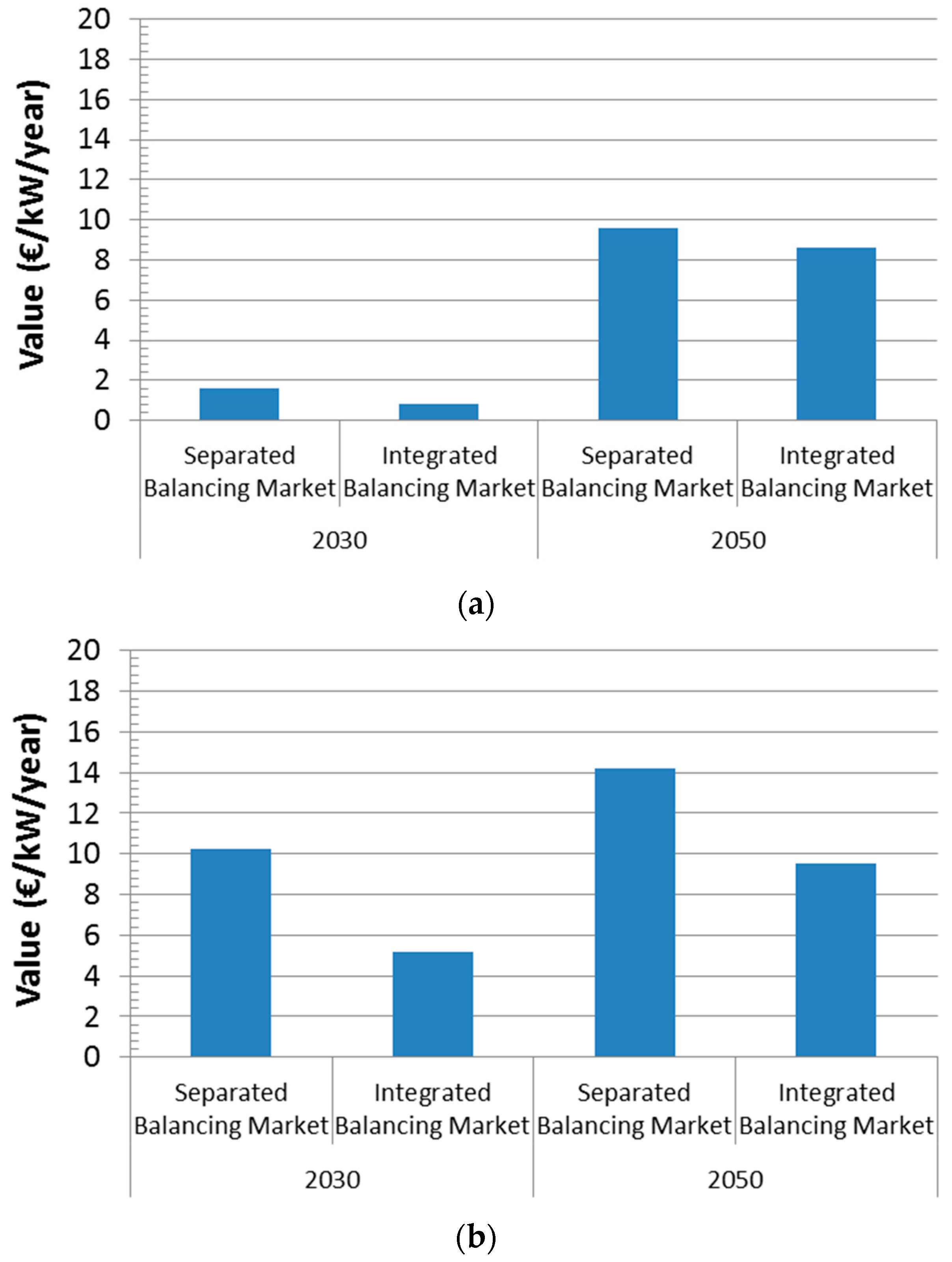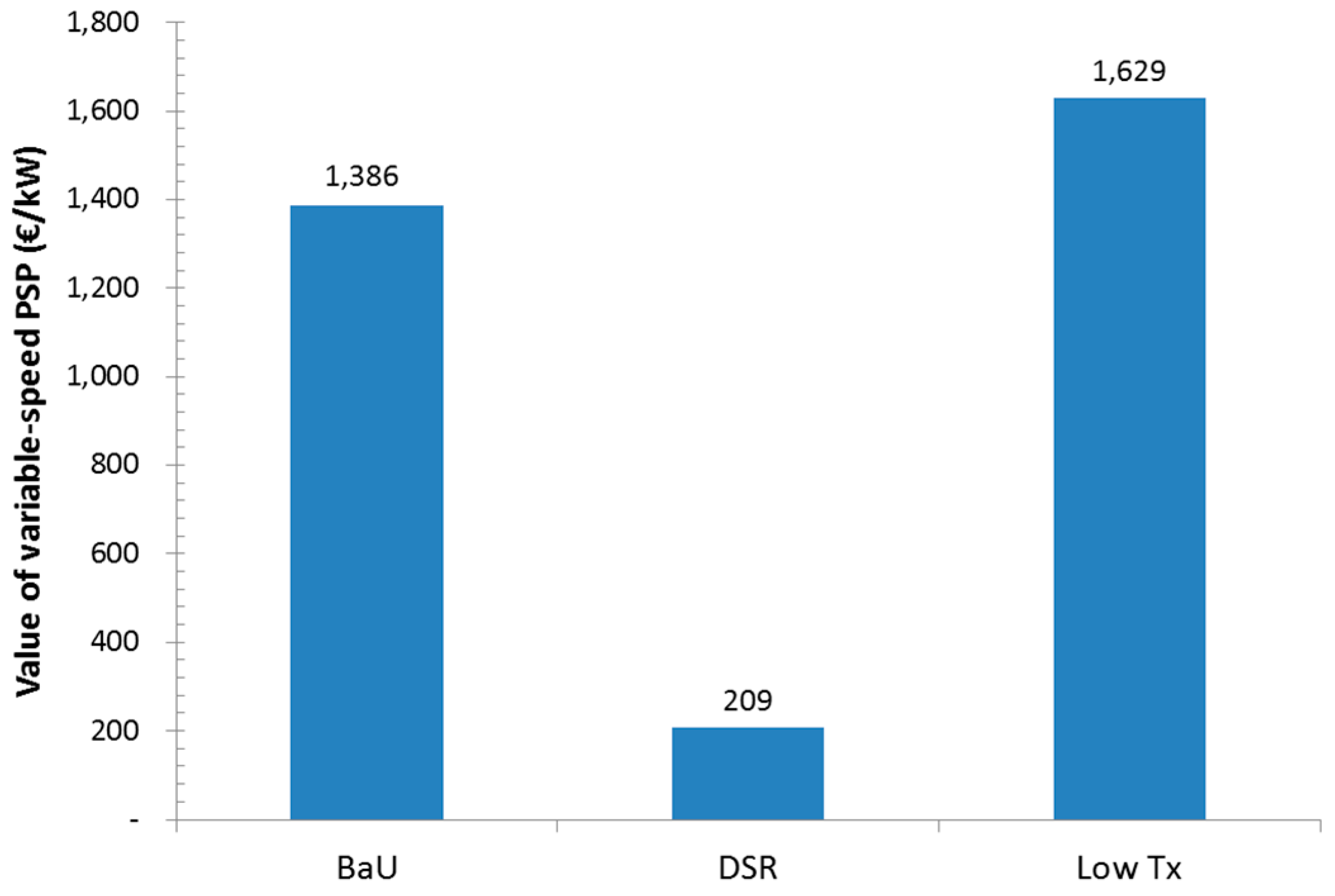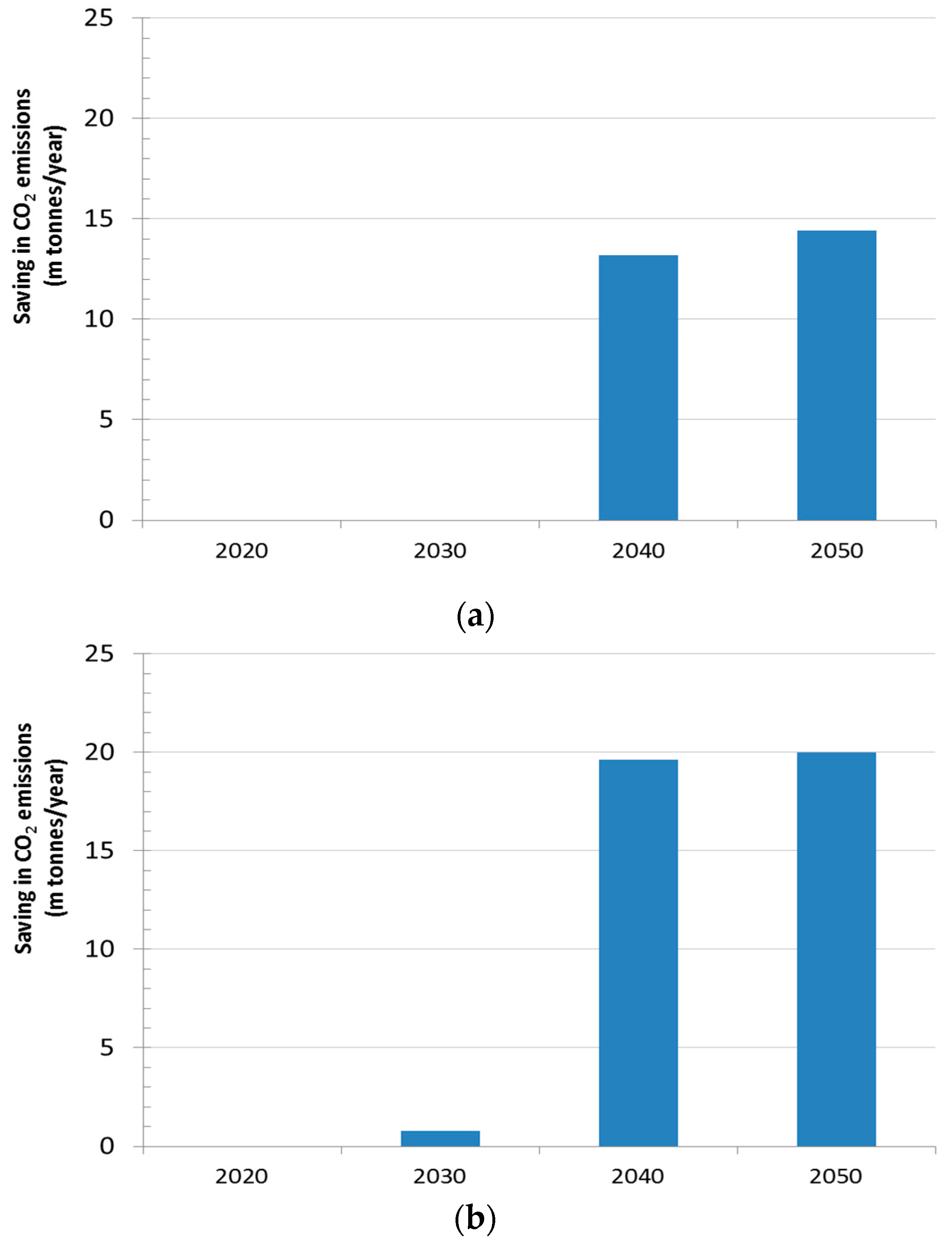1. Introduction
High shares of intermittent renewable energy resources (RES) will be integrated into the future electricity systems. This will present fundamental challenges for maintaining efficient operation and planning of power systems. Energy storage may support the system integration of RES by improving the flexibility of system operations to accommodate the variability of RES output, allowing higher utilisation of RES and other low-carbon technologies, while at the same time supporting the system by providing capacity and ancillary services. The use of energy storage to support system operations through improving the utilisation of the low marginal cost plants and supporting frequency regulation is not a new concept. Short-term energy storage is normally charged during off-peak hours, utilising base-load generation and improving its load factor, and then discharged during peak conditions to reduce the need to run high marginal cost peaking plants. In addition, pumped storage plant (PSP) technologies with high dynamic response capabilities have been available in European electricity systems for decades, although today’s overall utilisation is relatively low, suggesting that this technology may not often be needed by the system. However, the role of energy storage including PSPs may become much more critical going forward as the system operation issues triggered by high penetration of RES progressively exacerbate.
Previous research studied the capability of energy storage in performing energy arbitrage [
1] or providing reserve services [
2] in systems with a high penetration of RES. In this respect, a framework to assess the system benefits and market potential of energy storage is proposed in [
3]. The authors in [
4] present a detailed review on the operation of hydro plants. The capability of energy storage to contribute simultaneously to energy and frequency service markets is analysed in [
5,
6]. In addition, energy storage systems are used to manage the variability of wind and PV generation in [
7,
8]. In order to optimally allocate storage capacity among multiple services, stochastic optimisation approaches are particularly suitable for studying the value of energy storage in systems with large shares of RES, such as the one provided in [
9]. Previous work also investigated a number of different storage technologies and their potential applications, such as stochastic optimisation of PSP units [
10] to support market participation of wind generation; grid-scale application of batteries [
11]; or sizing of flow batteries [
12]. Energy storage can also support the system security by providing capacity during peak demand conditions, hence reducing the generating capacity needed by the system; for example, the reliability benefits of energy storage in a system with high penetration of RES were quantified in [
13].
Optimising all aspects of energy storage applications is computationally challenging and complex as it must consider not only the generation and transmission capacity requirements and availability of resources in the long term but also system operation needs in the short term. The need to assess the full system value of storage technologies in a holistic manner is important to inform the optimal investment in energy storage. Technology improvements, such as installing variable-speed machines for PSPs [
14], may be possible but are conditional on the existence of a positive business case. The new variable-speed PSP can provide frequency regulation in both charging and discharging modes, while traditionally the PSP could only provide regulation services in generation mode. Furthermore, the significant potential of pumped storage in Europe is identified in [
15]. The authors in [
16] further demonstrate the potential cross-border impact of hydro storage development in Norway on other European countries. Considering that many of the European PSP assets will soon reach the end of their lifetime or require major refurbishment, understanding the value of emerging storage technologies will be crucial for allowing timely development of new technologies. A recent work in [
17] analyses the extra operational benefit of variable-speed over fixed-speed PSPs in a joint energy and secondary regulation reserve market, and the results suggest that a variable-speed PSP can increase its income by up to 163%. However, the whole-system value of the variable-speed PSP has not yet been assessed.
In this context, the main contribution of this paper is the development of a methodology to characterise and quantify the whole-system value of fixed and variable-speed PSPs in the context of the future decarbonised European electricity system. The same approach is also applied to evaluate the impact of improvements of PSP cycle efficiency on system cost savings in the future European electricity system. The analytical framework developed in this paper involves the use of a combination of a deterministic system planning model [
18] and a stochastic system operation model [
19]. By using this approach, the paper tries to quantify the value of PSPs in a holistic manner while considering the potential synergies and conflicts from multiple applications of PSPs in the energy system. The application of this approach was tested on a reduced model of the Pan-European power system, and a range of case studies was carried out to enable the valuation of different PSP technologies.
The paper is structured as follows. In
Section 2, the proposed approach is described using a combination of investment and system operation optimisation methodologies to evaluate the whole-system value of PSP technologies. The applications of the proposed approach in a set of case studies are discussed in
Section 4. Based on the results of these studies, the key findings are summarised in the last section.
2. Approach
2.1. Modelling Structure
As shown in
Figure 1, the combination of a deterministic system planning tool (i.e., the Whole-electricity System Investment Model (WeSIM)) and a stochastic system operation optimisation tool (i.e., the Advanced Stochastic Unit Commitment (ASUC)) is used to analyse and quantify the system benefits of PSP technologies. The approach decouples the planning problem (which considers a large number of operating snapshots in a year (or multiple years) to determine the impact of certain technologies on the system capacity requirements) from the operational problem (which explicitly considers the uncertainty, especially with respect to RES output). The operational model (ASUC) allocates a sufficient amount of operating reserves and frequency response across the system, while balancing the associated costs and benefits, to provide an adequate system balancing capability.
Given the high complexity of both WeSIM and ASUC, to integrate them into a single model that simultaneously optimises investment and operation decisions under multiple sources of uncertainty is extremely challenging. Decomposition of the problem into planning and operation domains is necessary as the size of the integrated problem, and hence the associated computational times would be prohibitive. In this case, the information on the detailed system operation may not be fully included in the planning problem, although most of it is captured through the simplified representation.
In this approach, WeSIM optimises the capacity of the power system infrastructure including transmission and generation while taking into account the security of supply requirements, as well as determining the daily usage patterns of hydroelectric generation and energy storage. The outputs of WeSIM are passed to ASUC as input data to specify the system capacity and daily usage of hydro/storage. ASUC then co-optimises the energy dispatch and the allocation of reserve and response services to deal with the uncertainty of RES and unplanned generation outages. An overview of both models, as well as the generic model developed for PSPs, is given in the following section.
2.2. Whole-Electricity System Investment Model
As shown in
Figure 2, WeSIM [
18] seeks to minimise the overall cost of additional generating capacity, additional inter-regional transmission capacity and annual system operation. The shortest time horizon in this optimisation problem is an hourly/half hourly system dispatch problem. Ancillary service requirements are included to cover the real-time system balancing problems that have a shorter time resolution. The long-term investment and short-term operation problems are solved in one shot to guarantee the optimality of the solution. One year-round optimisation problem with an annuitised investment cost is applied so that the optimal investment decisions can be achieved through balancing the investment cost and operating cost.
As WeSIM is applied in the interconnected EU system (i.e., not just for individual countries), the effects of generation capacity sharing through an inter-regional transmission network can be captured and hence the overall costs of additional infrastructure for a given level of reliability can be minimised. The security of supply criterion applied in the model is defined by the loss of load expectation (LOLE) parameter, assuming that each country has a uniform standard of keeping LOLE at no more than a few (3–4) hours per year. LOLE is calculated in the model through assessing the generation adequacy for each hour of the year. This is derived by using an array of probabilistic inputs that are considered in the model, including forced outages of the generating plants, an optimised production schedule from the available conventional generation technologies, seasonal availability of hydropower, the probable generation from renewable energy and the associated short and long-term correlations with demand. Demand-side response and energy storage facilities are explicitly modelled to assess their impacts on the required generating capacity and inter-regional transmission investments while maintaining the given level of system reliability.
Key inputs to WeSIM include hourly electricity demand profiles, regional hourly profiles for RES, seasonal hydro energy profiles, installed capacity, dynamic characteristics and operating costs of generation, investment cost of generating capacity in different regions, network topology and associated reinforcement costs. Key outputs of the model are the additional generating capacity and inter-regional secured transmission capacity, optimal hourly dispatch for generators and energy storage, as well as the utilisation of flexible demand.
The optimisation problem is subject to the constraints that are associated with the dynamic characteristics (stable generation levels, ramp rates, minimum up/down times etc.), cost parameters of various technologies and pre-defined ancillary service requirements obtained from the analytical statistics of the energy availability profiles of RES. The detailed mathematical equations can be found in [
18].
2.3. Advanced Stochastic Unit Commitment
Driven by the inherent uncertainty, variability and limited inertia capability of intermittent RES, the future low-carbon systems will require a much greater volume of ancillary services in order to maintain the system balance. This may significantly increase the benefits of PSPs. However, in order to capture the full value of PSPs, it is critical to optimally allocate plant capacities across multiple services [
19]. Furthermore, the integrated balancing market across Europe is gradually developing, which may fundamentally change the role and value of PSPs in the future European electricity system.
In this context, the ASUC model is applied to quantify the operational cost savings that could be achieved by installing or upgrading PSPs. In this assessment, the model considers the impact of the key characteristics of intermittent RES on the ancillary service requirements while also capturing the effect of different balancing market designs.
As shown in
Figure 3, the key inputs to the ASUC model include a time series of hourly electricity demand, regional hourly profiles for RES, operating profiles for seasonal hydro plants, installed capacity of thermal plants and associated dynamic characteristics, fuel and carbon prices, inter-regional network topology and transmission capacity. The main outputs of the model are the optimal commitment and dispatch decisions for thermal plants and energy storage plants, inter-regional energy and balancing services exchange, system operation cost, and carbon emissions.
ASUC optimises the commitment as well as dispatch decisions for the generators, energy storage and cross-border exchanges in the EU electricity system to minimise the overall system operating cost, subjects to system constraints, including the load balance constraint, primary/secondary frequency response constraints and transmission capacity limits; local constraints for thermal units, such as minimum stable generation, start-up time, minimum up/downtime, ramping rates, primary/secondary frequency response capabilities, as well as the relevant constraints for energy storage. The operational decisions are optimised over a multi-stage scenario tree, representing the range of possible outcomes of stochastic variables. Each path through the tree represents a possible outcome or scenario. Therefore, operating reserve requirements are endogenously optimised within the model. The inertia-dependent frequency response requirements can also be modelled in order to accurately take into account the declining level of system inertia. ASUC simulations are carried out with a rolling planning approach by performing a stochastic optimisation with a 24-h horizon, and discarding all decisions beyond the root node ones. In the next time step, realisations of some stochastic variables become available, which may be different from any existing scenario. Another SUC optimisation can be performed with an updated scenario tree covering a 24-h time horizon; the operational decisions are adjusted with the inter-temporal constraints maintained. The detailed mathematical equations can be found in [
19].
The operational value of PSPs is quantified as the operating cost savings from installing or upgrading PSPs in a certain European region or across entire Europe over the expected plant lifetime. ASUC is applied to calculate the annual system operation cost, considering both the delivery of energy as well as the provision of ancillary services. In the case of a separated balancing market, all of the ancillary services in each region have to be provided by the resources within the region, while in the case of an integrated balancing market, although the same amount of ancillary services are required, they are allowed to be provided from any resources across the system as long as there is available transmission capacity for the delivery of these services. The optimised 35-region system used in WeSIM is aggregated into a 9-node system, which is shown in
Figure 4.
2.4. Modelling of PSPs in Fixed-Speed and Variable-Speed Modes
This sub-section discusses a generic model of PSPs including both fixed-speed and variable-speed modes. The existing fixed-speed schemes rely on a relatively simple control scheme. The energy output of a PSP can be modified continuously only when it operates in the generation mode. In this operational mode, the PSP can provide reserves as well as frequency regulation (FR) support. However, when a PSP operates in the pumping mode (i.e., as a load), the storage unit can operate in only two discrete states—on or off—and hence cannot provide frequency regulation. The use of more advanced control technologies cannot only enable variable-speed PSP to provide frequency regulation during pumping operation but can also improve the efficiency of PSP schemes.
Physical constraints associated with energy storage used in system planning and operation include: (i) charge rate limits (Equation (1)) and discharge rate limits (Equation (2)); (ii) stored energy balance constraints (Equation (3)); and (iii) constraints associated with the amount of energy that can be stored (Equation (4)). Note that for a fixed-speed PSP,
.
Provision of FR requires energy storage to provide extra power for 30 min. Therefore, additional constraints are developed for ES to keep sufficient headroom and the level of stored energy, if scheduled to provide the services.
FR service provision constraints include: (i) maximum FR capability (Equation (5)); (ii) storage headroom constraints associated with response provision (Equation (6)); and (iii) stored energy constraints associated with response provision (Equation (7)). For a fixed-speed PSP in the pumping mode, Equation (6) limits the frequency response provision to zero.
3. Case Studies
The transmission system is modelled by a simplified representation of the interconnections of EU-28 plus Norway, Switzerland and the Balkan countries. This has been developed to provide insights and to quantify the need for energy interchange from regions with high RES potential to demand centres throughout Europe. The system is presented by 35 regions and 78 cross-border links including the potential links (i.e., the links that do not exist today but can be developed in the future) such as France–Ireland, Denmark–Poland, etc. The economic benefits of energy storage and of the upgrade of PSPs into variable speed are quantified taking into account both short-term and long-term impacts on the system capacity requirements and operation considering the possible evolution of the European power system in the future. Based on the system background specified in [
20,
21], two main scenarios have been developed for the purpose of this study: (1) low RES scenario and (2) high RES scenario. Each scenario has four snapshot years covering the period from 2020 to 2050 with a 10-year time interval. Renewable contribution to the supply mix in 2050 is around 56% in the low RES scenario and 80% in the high RES scenario.
Figure A1,
Figure A2,
Figure A3,
Figure A4,
Figure A5,
Figure A6,
Figure A7 and
Figure A8 in the
Appendix A describe the detailed system background.
3.1. Fundamental Economic Value of Fixed-Speed and Variable-Speed PSPs
By collating all of the results obtained, case studies offer a comprehensive view depicting the benefits of having PSPs in Europe for different PSP technologies. The benefits are presented in
Figure 5 in the form of savings in generation capacity cost (Gen CAPEX) and transmission capacity cost (Tx CAPEX) and operation cost (OPEX). To clearly demonstrate the additional benefits of variable-speed PSPs and higher cycling efficiency, the results are presented in an incremental fashion.
The actual cost of PSPs is normally confidential and very difficult to access. Furthermore, the associated costs in the future are subject to significant uncertainty due to technology innovation and it is also highly location specific. Therefore, the results presented here are based on gross system benefits (i.e., the cost savings from PSPs) and/or variable speed technologies without counting the installation costs. The gross system value represents a useful benchmark to compare with the cost of installing new PSPs or upgrading existing ones to perform cost-benefit analysis; however, the estimate of the cost of PSP schemes is not the subject of this study.
From the results, it is clear that when present in the system, PSPs can reduce the total system cost by reducing the system capacity requirements and improving the efficiency of system operation. These system-level benefits would be offset to a smaller or larger extent by the investment cost into PSP schemes; however, this study focuses on system benefits without discounting for the PSP investment cost.
The gross value increases with the increased penetration of renewables into the system. In the high RES scenario (80% RES), around €13 billion per year savings can be achieved in the electricity sector in 2050, while on the other hand the short-term savings in 2020 are only around €1 billion per year. Much lower values are obtained in the low RES scenario (60% RES). It can be concluded that high penetration of RES is one of the main drivers for the value of PSPs.
The results also indicate that—for the short-term savings or in the low RES scenario—the savings come predominantly from the reduction in the infrastructure cost, while in the high RES scenario the largest savings beyond 2030 come from the savings in OPEX, as a consequence of improving the utilisation of renewables and other low marginal cost generators.
Upgrading the PSP with variable-speed drive enhances its benefits by 10–20% in the long run (2050). For example, the total benefit of a fixed-speed PSP is €4.1bn/year in the low RES scenario; this can be increased to €5.05bn/year with the variable-speed upgrade. The studies suggest that the main benefit of the upgrade comes from the 10% improvement in efficiency while, at the same time, it enables the PSP to provide frequency regulation during pumping mode.
To provide an easier comparison with the possible investment cost of PSP schemes, the system benefits presented in
Figure 5 are divided with the total installed capacity of PSPs and expressed in €/kW per annum, from which the capitalised value is calculated per kilowatt (kW) of installed storage capacity for different PSP options. The capitalised value is calculated from the annualised value by assuming 10% cost of capital and 40 years economic lifetime, yielding a ratio between capitalised and annualised value of 9.8. The capitalised value of the PSP increases from around €200/kW in 2020 to around €700/kW in 2050 in the low RES scenario, or from around €171/kW in 2020 to €1490/kW in 2050 in the high RES scenario. The results are presented in
Figure 6.
Note that the assumption on the cost of capital may be considered conservative from the perspective of system valuation of PSP technologies, although it has been reported in the literature [
22]. Lower values of cost of capital would result in higher capitalised values of PSP technologies represented in
Figure 6. For instance, if the assumed cost of capital is reduced to 7% or 5%, the capitalised to annualised value ratio would increase by 36% and 75%, respectively, as would the values of PSP technologies reported in
Figure 6.
3.2. Impact on Cross-Border Capacity Requirement
The adjustable load of PSPs during pumping mode can also be used to control power flows, therefore improving the congestion management of the European transmission network. In the long term, this will reduce the interconnection capacity required as indicated by the results shown in
Figure 7. Increasing the cycle efficiency of PSP storage also reduces the network capacity requirement. Higher efficiency allows PSPs to be more focused on improving local consumption of electricity generated from low marginal cost generators and therefore leads to a lower requirement for new interconnection capacity. However, as it would still be preferred to use most of the electricity directly in order to mitigate storage losses, if there are no significant barriers in the development of new cross-border capacity, the magnitude of the impact on network capacity is actually limited and relatively small in the long term.
3.3. Impact of Integrating European Balancing Markets
The value of upgrading into variable-speed PSPs also depends on how the balancing markets across Europe are integrated. This section considers two main cases for the future Europe balancing market: (1) separated balancing market with the balancing market of each region cleared within its own geographical boundaries and without the opportunity for importing or exporting balancing services, and (2) integrated balancing market where trading of balancing services is allowed across national and regional borders (while respecting the available transmission capacity). As shown in
Figure 8, without integration the overall value of storage tends to be higher as the balancing requirements have to be provided by the sources within the same region and there is no access to potentially cheaper balancing providers across the border. As a consequence, this will increase the use of out-of-merit system resources in regions with a high demand for balancing services, such as regions with a large penetration of renewable power generation. The integration of balancing markets on the other hand allows the balancing resources to be shared across Europe (subject to sufficient transmission infrastructure). The integration (i.e., pooling of balancing resources) will reduce the overall system costs and thus decrease the benefit for variable-speed PSPs when observed at the European level.
However, this trend can be different at the regional level. For example, the integrated market is actually preferred by variable-speed PSPs in the mid and central European regions as it will increase the value of the PSP in those regions. This is driven by the sufficient balancing resources already present in those two regions, and by allowing these resources including PSPs to contribute to the provision of balancing services in other regions, it will increase their whole-system value. At the same time, the upgraded PSPs in the UK and Ireland would prefer separated balancing markets given that these systems will require large volumes of balancing services, therefore increasing their value. This is primarily driven by the generation mix of the electricity systems in the UK and Ireland that rely mainly on flexible conventional gas-fired plants to provide balancing services. Strengthening the interconnection between the UK/Ireland and Central Europe and allowing balancing services to be shared across adjacent regions will reduce the cost of balancing services in the UK and Ireland and hence the value of variable-speed PSPs located there.
3.4. Competing Technologies for PSP
The impact of the availability of competing flexible technologies such as demand-side response (DSR) or increased interconnection capacity has also been analysed. The results (
Figure 9) show a significant reduction in the capitalised value of PSPs in the systems with DSR. The value drops by more than 84%, from €1386/kW (the value found in the system without DSR in the high RES scenario) to only €209/kW. Despite the reduction in value, the application of PSPs can still reduce the demand for generation, network capacity and operating costs although on a much smaller scale. This suggests that although DSR can be a competitor to PSPs, at small uptake levels it can also work complementarily with PSPs to further optimise the use of system infrastructure.
On the other hand, the value of a PSP increases when the interconnection capacity is sub-optimal. This is illustrated in the “Low Tx” scenario where the capacity of interconnectors is halved compared to the cost-optimal solution, and as a result the capitalised value of the PSP is found to increase by 18%. In this case, the operating cost savings driven by PSPs increase significantly, while there is very little effect on savings in generation and transmission investment. Without strong interconnectors, the need to procure balancing services locally increases, which would generally improve the business case for the PSP. Conversely, the expansion of interconnection capacity and establishing a pan-European balancing market would benefit PSPs in certain countries or regions by enabling them to export their flexible services to other markets where there may be a lack of flexible resources, as discussed in more detail in
Section 3.3.
3.5. Reduction of CO2 Emissions
The benefit of PSPs in reducing power system emissions in the two scenarios is shown in
Figure 10. Carbon reduction is largely negligible by 2030, which is the result of the assumptions behind the two scenarios used in this study. Given that in 2020 and 2030 the PSP effectively displaces the output of high marginal cost peaking plants and replaces it with an increased output of baseload and mid-merit conventional generation, a large share of which is coal-fired in the short term, the carbon savings are negligible. The results on the other hand show that from 2040 onwards the emission savings can be considerable. In the low RES scenario, the reduction in emissions is in the order of 13 to 14 million tonnes per year by 2040 and 2050, respectively. Even higher carbon reduction is observed in the high RES scenario, at the level of 20 million tonnes per year by 2050. These carbon savings driven by PSPs constitute around 6–10% of the total annual carbon emissions from the electricity sector in Europe.
Emission savings quantified here take into account the efficiency losses of PSPs, highlighting the fact that in order for a PSP to contribute to reducing emissions, it needs to improve the utilisation of renewables or other low-carbon technologies. This becomes particularly significant in systems with very high penetrations of RES and other low-carbon generating technologies, such as those projected in 2040 and 2050.
4. Conclusions
The key outcome of the approach presented in this paper is the quantification of the benefits of PSP technology and its enhancements taking into account both short-term and long-term impacts on system capacity requirements and operation. Quantitative studies have been carried out through a combined implementation of WeSIM and ASUC models, evaluating the impact of PSPs on power generation and transmission capacity requirements, capital costs, system operating costs and carbon emissions, including the impact of upgrading existing fixed-speed PSPs to variable speed. The analysis has also addressed the impact of competing technologies such as demand-side response and interconnection on the system value of PSPs.
The case studies presented in this paper have considered the possible evolution of the European power system from 2020 to 2050, and demonstrated that PSPs could reduce the total system cost by reducing the system capacity requirements and improving the efficiency of system operation. Within the modelling assumptions in this paper, cost savings of up to €13bn per year may be achieved in the electricity sector in 2050 under the high RES scenario; savings in the low RES scenario would be much lower. Upgrading the PSP to variable-speed drive was found to increase its long-term benefits by 10–20%. However, the integration of European balancing markets may potentially reduce the overall value of variable-speed PSPs, although the effect will generally differ across different regions. The results also show a significant reduction in the value of variable-speed PSPs in the system with a high DSR uptake. On the other hand, the value of PSPs increases by 18% when the interconnection capacity is constrained with respect to the cost-optimal volume. The benefit of PSPs in reducing emissions is relatively negligible by 2030 but increases considerably beyond 2030, delivering carbon reductions of 6–10% of the total annual carbon emissions from the electricity sector in Europe in 2050.
In the next step, we plan to investigate the possibility of integrating WeSIM and ASUC into a single model so that the operational uncertainty can be fully included in the planning problem. Furthermore, a market-based analysis needs to be carried out to further understand the role of PSPs from the investors’ point of view.


